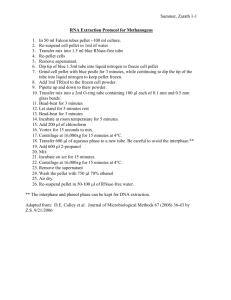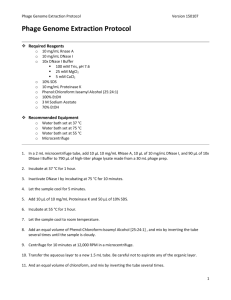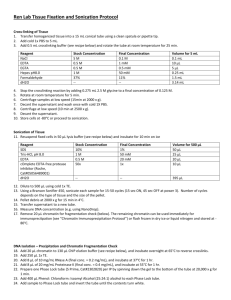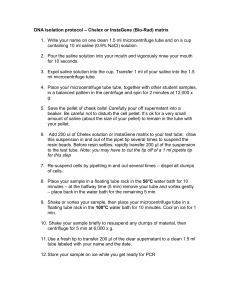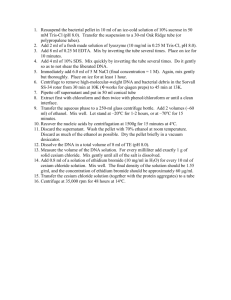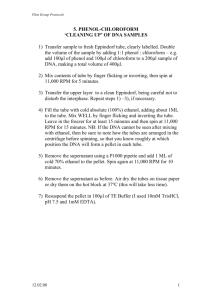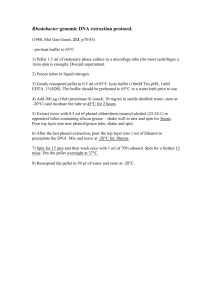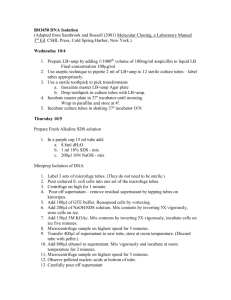Chr19tp clone rearray – BlueGnome 1Mb
advertisement
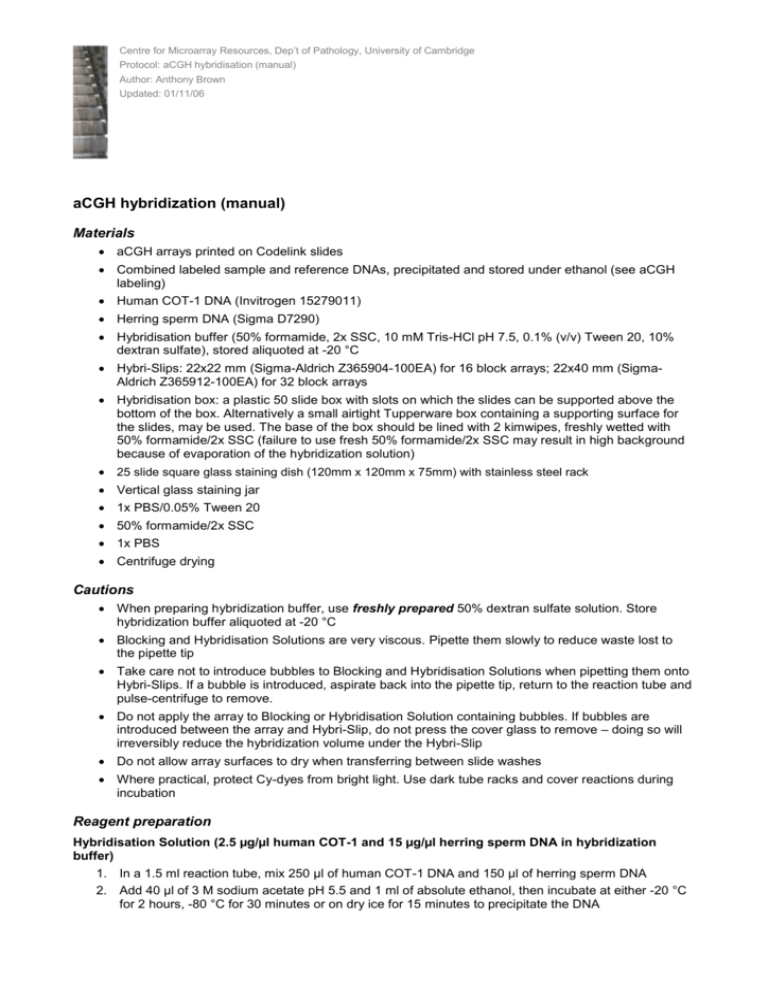
Centre for Microarray Resources, Dep’t of Pathology, University of Cambridge Protocol: aCGH hybridisation (manual) Author: Anthony Brown Updated: 01/11/06 aCGH hybridization (manual) Materials aCGH arrays printed on Codelink slides Combined labeled sample and reference DNAs, precipitated and stored under ethanol (see aCGH labeling) Human COT-1 DNA (Invitrogen 15279011) Herring sperm DNA (Sigma D7290) Hybridisation buffer (50% formamide, 2x SSC, 10 mM Tris-HCl pH 7.5, 0.1% (v/v) Tween 20, 10% dextran sulfate), stored aliquoted at -20 °C Hybri-Slips: 22x22 mm (Sigma-Aldrich Z365904-100EA) for 16 block arrays; 22x40 mm (SigmaAldrich Z365912-100EA) for 32 block arrays Hybridisation box: a plastic 50 slide box with slots on which the slides can be supported above the bottom of the box. Alternatively a small airtight Tupperware box containing a supporting surface for the slides, may be used. The base of the box should be lined with 2 kimwipes, freshly wetted with 50% formamide/2x SSC (failure to use fresh 50% formamide/2x SSC may result in high background because of evaporation of the hybridization solution) 25 slide square glass staining dish (120mm x 120mm x 75mm) with stainless steel rack Vertical glass staining jar 1x PBS/0.05% Tween 20 50% formamide/2x SSC 1x PBS Centrifuge drying Cautions When preparing hybridization buffer, use freshly prepared 50% dextran sulfate solution. Store hybridization buffer aliquoted at -20 °C Blocking and Hybridisation Solutions are very viscous. Pipette them slowly to reduce waste lost to the pipette tip Take care not to introduce bubbles to Blocking and Hybridisation Solutions when pipetting them onto Hybri-Slips. If a bubble is introduced, aspirate back into the pipette tip, return to the reaction tube and pulse-centrifuge to remove. Do not apply the array to Blocking or Hybridisation Solution containing bubbles. If bubbles are introduced between the array and Hybri-Slip, do not press the cover glass to remove – doing so will irreversibly reduce the hybridization volume under the Hybri-Slip Do not allow array surfaces to dry when transferring between slide washes Where practical, protect Cy-dyes from bright light. Use dark tube racks and cover reactions during incubation Reagent preparation Hybridisation Solution (2.5 µg/µl human COT-1 and 15 µg/µl herring sperm DNA in hybridization buffer) 1. In a 1.5 ml reaction tube, mix 250 µl of human COT-1 DNA and 150 µl of herring sperm DNA 2. Add 40 µl of 3 M sodium acetate pH 5.5 and 1 ml of absolute ethanol, then incubate at either -20 °C for 2 hours, -80 °C for 30 minutes or on dry ice for 15 minutes to precipitate the DNA Centre for Microarray Resources, Dep’t of Pathology, University of Cambridge Protocol: aCGH hybridisation (manual) Author: Anthony Brown Updated: 01/11/06 3. Pellet at full speed in a benchtop microcentrifuge for 15 minutes 4. Decant and discard the supernatant, and replace with 1 ml of 70% ethanol. Mix gently by inverting the tube 5. Centrifuge at full speed in a benchtop microcentrifuge for 5 minutes 6. Decant and discard the supernatant, and keeping the tube inverted, gently tap the top of tube on a folded tissue to remove remaining droplets. Take care not to dislodge the pellet from the tube base 7. Immediately pulse-spin the tube in a benchtop microcentrifuge to collect any remaining ethanol in the base of the tube. Carefully remove the remaining ethanol from the tube with a P10 tip, taking care not to touch the pellet 8. Allow the pellet to dry at room temperature for 5 minutes 9. Add 100 µl of hybridisation buffer to the pellet. Incubate the tube at 75 °C for 10 minutes, flicking the tube vigorously every few minutes to dissolve the pellet. Do not proceed until the pellet has dissolved completely. Vortex if necessary. Store at -20 °C until required Slide Blocking Solution (15 µg/µl herring sperm DNA in hybridization buffer) 1. Place 400 µl of herring sperm DNA in a 1.5 ml reaction tube 2. Follow steps 2 – 8 (above, Hybridisation Solution) 3. Add 266 µl of hybridisation buffer to the pellet. Incubate the tube at 75 °C for 10 minutes, flicking the tube vigorously every couple of minutes to dissolve the pellet. Do not proceed until the pellet has dissolved completely. Vortex if necessary. Store at -20 °C until required Method Slide blocking 1. Prepare a hybridization chamber by placing a layer of tissue in the base of a 50 position plastic slide box. In a fume hood, wet the tissue with 50% formamide/2xSSC, pouring away any excess 2. Incubate Slide Blocking Solution to 75 °C for 10 minutes to denature the herring sperm DNA 3. Remove the films from both sides of a Hybri-Slip, and place on the top edge of an empty clean tip box 4. Pulse-spin the denatured Slide Blocking Solution in a benchtop microcentrifuge and apply 30 µl or 60 µl, respectively, to the centre of the 22x22 mm or 22x40 mm HybriSlip, taking care not to introduce any bubbles 5. Lower the array gently onto the Hybri-Slip. When fixed, gently invert the slide. Check the position of the Hybri-Slip with an array template, and adjust carefully with clean forceps, if necessary, until the array is covered 6. Place in a hybridisation box containing tissue thoroughly wetted with 2xSSC/50% formamide. Incubate in a waterbath at 37 °C for 2 hours Prehybridisation 7. Pellet the labeled DNA samples at full speed in a benchtop microcentrifuge for 15 minutes 8. Decant and discard the supernatant, add 250 µl of 70% ethanol, mix by inversion and spin at full speed in a benchtop microcentrifuge for 5 minutes 9. Decant and discard the supernatant, and keeping the tube inverted, gently tap the top of tube on a folded tissue to remove remaining droplets. Take care not to dislodge the pellet from the tube base 10. Immediately pulse-spin the tube in a benchtop microcentrifuge to collect any remaining ethanol in the base of the tube. Carefully remove the remaining ethanol from the tube with a P10 tip, taking care not to touch the pellet 11. Allow the pellet to dry at room temperature for 5 minutes 12. To the pellet, add 25 µl or 50 µl of Hybridisation Solution, for 16- or 32-pin arrays, respectively. Incubate the tube at 75 °C for 10 minutes, flicking the tube vigorously every few minutes to dissolve the pellet. Do not proceed until the pellet has dissolved completely. Vortex if necessary 13. Denature at 75 °C for 10 minutes, pulse-spin in a benchtop microcentrifuge, and incubate at 37 °C for 2 hours. Centre for Microarray Resources, Dep’t of Pathology, University of Cambridge Protocol: aCGH hybridisation (manual) Author: Anthony Brown Updated: 01/11/06 Hybridisation 14. Remove the coverslip from the blocked array by repeated dunking in 1x PBS in a square glass staining dish. Transfer quickly to a vertical glass staining jar of 1x PBS and place on a rocking platform at full speed for 5 minutes 15. Transfer to a slot of a 50 position plastic slide box lined with a dry kimwipe and dry by centrifugation at 1000 rpm for 3 minutes in a 96-well spin-out plate rotor 16. Remove the films from both sides of a Hybri-Slip, and place on the top edge of an empty clean tip box 17. Pulse-spin the Hybridisation Solution in a benchtop microcentrifuge and apply 22 µl or 45 µl, respectively, to the centre of the 22x22 mm or 22x40 mm Hybri-Slip, taking care not to introduce any bubbles 18. Lower the array gently onto the Hybri-Slip. When fixed, gently invert the slide. Check the position of the Hybri-Slip with an array template, and adjust carefully with clean forceps, if necessary, until the array is covered 19. Place in a hybridisation box containing tissue thoroughly wetted with 2xSSC/50% formamide. Incubate in a waterbath at 37 °C for 21-24 hours Washing 20. Remove the coverslip from the hybridised array by repeated dunking in 1x PBS/0.05% Tween 20 21. Transfer quickly to the outer positions of a stainless steel rack in a square glass staining dish containing 400 ml of 1x PBS/0.05% Tween 20. Place on a magnetic stirrer stir, add a stir bar and stir in the dark for 10 minutes (cover with foil if necessary). A gentle vortex should be visible on the surface of the solution 22. Transfer the rack quickly to a square glass staining dish containing 400 ml of fresh 1x PBS/0.05% Tween 20. Place on a magnetic stirrer stir, add a stir bar and stir in the dark for 10 minutes. A gentle vortex should be visible on the surface of the solution 23. Repeat step 22 24. Transfer to a prewarmed vertical staining dish containing prewarmed 2x SSC/50% formamide and incubate on a fast rocker at 42 °C in the dark for 30 minutes. 25. Repeat step 22 26. Transfer the rack quickly to a square glass staining dish containing 400 ml of fresh 1x PBS (without Tween 20). Place on a magnetic stirrer stir, add a stir bar and stir in the dark for 10 minutes. A gentle vortex should be visible on the surface of the solution 27. Repeat step 26 28. Transfer to a slot of a 50 position plastic slide box lined with a dry kimwipe and dry by centrifugation at 1000 rpm for 3 minutes in a 96-well spin-out plate rotor
